9. The 3 ends of polI and polIII transcripts are generated by termination
22.8 Yeast tRNA splicing involves cutting and rejoining |
The splicing reactions that we have discussed so far depend upon short consensus sequences and occur by transesterification reactions in which breaking and making of bonds is coordinated. The splicing of tRNA genes is achieved by a different mechanism that relies upon separate cleavage and ligation reactions.
About 40 of the ~400 nuclear tRNA genes in yeast are interrupted. Each has a single intron, located just one nucleotide beyond the 3′ side of the anticodon. The introns vary in length from 14 V46 bp. Those in related tRNA genes are related in sequence, but the introns in tRNA genes representing different amino acids are unrelated. There is no consensus sequence that could be recognized by the splicing enzymes. The same general rules apply to the nuclear tRNA genes of plants, amphibians, and mammals.
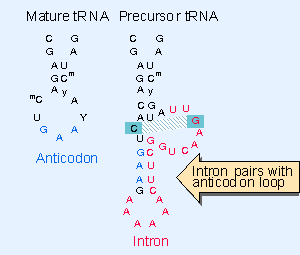 |
Figure 22.23 The intron in yeast tRNAPhe base pairs with the anticodon to change the structure of the anticodon arm. Pairing between an excluded base in the stem and the intron loop in the precursor may be required for splicing. |
All the introns include a sequence that is complementary to the anticodon of the tRNA. This creates an alternative conformation for the anticodon arm in which the anticodon is base paired to form an extension of the usual arm. An example is drawn in Figure 22.23. Only the anticodon arm is affected Xthe rest of the molecule retains its usual structure.
The exact sequence and size of the intron is not important. Most mutations in the intron do not prevent splicing. Splicing of tRNA depends principally on recognition of a common secondary structure in tRNA rather than a common sequence of the intron. Regions in various parts of the molecule are important, including the stretch between the acceptor arm and D arm, in the TΨ C arm, and especially the anticodon arm. This is reminiscent of the structural demands placed on tRNA for protein synthesis (see 6 Protein synthesis).
The intron is not entirely irrelevant, however. Pairing between a base in the intron loop and an unpaired base in the stem is required for splicing. Mutations at other positions that influence this pairing (for example, to generate alternative patterns for pairing) influence splicing. The rules that govern availability of tRNA precursors for splicing resemble the rules that govern recognition by aminoacyl-tRNA synthetases (as discussed in 6 Protein synthesis).
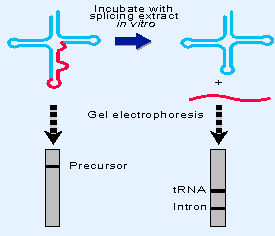 |
Figure 22.24 Splicing of yeast tRNA in vitro can be followed by assaying the RNA precursor and products by gel electrophoresis. |
In a temperature-sensitive mutant of yeast that fails to remove the introns, the interrupted precursors accumulate in the nucleus. The precursors can be used as substrates for a cell-free system extracted from wild-type cells. The splicing of the precursor can be followed by virtue of the resulting size reduction. This is seen by the change in position of the band on gel electrophoresis, as illustrated in Figure 22.24. The reduction in size can be accounted for by the appearance of a band representing the intron.
The cell-free extract can be fractionated by assaying the ability to splice the tRNA. The in vitro reaction requires ATP. Characterizing the reactions that occur with and without ATP shows that the two separate stages of the reaction are catalyzed by different enzymes.
- The first step does not require ATP. It involves phosphodiester bond cleavage, taking the form of an atypical nuclease reaction. It is catalyzed by an endonuclease.
- The second step requires ATP and involves bond formation; it is a ligation reaction, and the responsible enzyme activity is described as an RNA ligase.
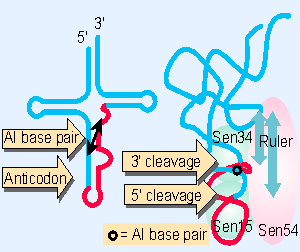 |
Figure 22.25 The 3 F and 5 F cleavages in S. cerevisiae pre-tRNA are catalyzed by different subunits of the endonuclease. Another subunit may determine location of the cleavage sites by measuring distance from the mature structure. The AI base pair is also important. |
The endonuclease is responsible for the specificity of intron recognition. It cleaves the precursor at both ends of the intron. The yeast endonuclease is a multimeric protein. Its activities are illustrated in Figure 22.25. The subunits Sen34 and Sen2 cleave the 3′ and 5′ splice sites, respectively. Subunit Sen54 may determine the sites of cleavage by "measuring" distance from the mature domain. Although it was originally thought that the sequence of the intron was irrelevant, it participates in base pairing that is required for cleavage. The AI base pair that forms between the first base in the anticodon loop and the base preceding the 3′ splice site is required for 3′ splice site cleavage (Reyes and Abelson, 1988; Mattoccia et al., 1988; Baldi et al., 1992).
An interesting insight into the evolution of tRNA splicing is provided by the endonucleases of archaea. These are homodimers or homotetramers, in which each subunit has an active site (although only two of the sites function in the tetramer) that cleaves one of the splice sites. The subunit has sequences related to the sequences of the active sites in the Sen34 and Sen2 subunits of the yeast enzyme. So the origin of splicing of tRNA precedes the separation of the archaea and the eukaryotes. If it originated by insertion of the intron into tRNAs, this must have been a very ancient event.
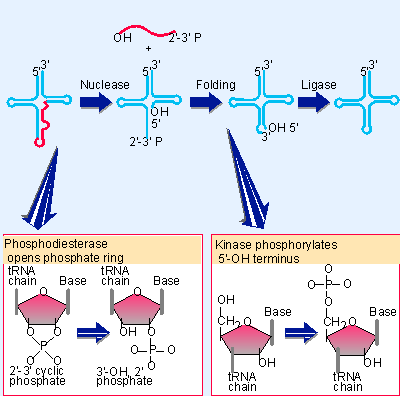 |
Figure 22.26 Splicing of tRNA requires separate nuclease and ligase activities. The exon-intron boundaries are cleaved by the nuclease to generate 2 F-3 F cyclic phosphate and 5 F OH termini. The cyclic phosphate is opened to generate 3 F-OH and 2 F phosphate groups. The 5 F-OH is phosphorylated. After releasing the intron, the tRNA half molecules fold into a tRNA-like structure that now has a 3 F-OH, 5 F-P break. This is sealed by a ligase. |
The overall reaction is summarized in Figure 22.26. The products of cleavage are a linear intron and two half-tRNA molecules. These intermediates have unique ends. Each 5′ terminus ends in a hydroxyl group; each 3′ terminus ends in a 2′,3′-cyclic phosphate group. (All other known RNA splicing enzymes cleave on the other side of the phosphate bond.)
The two half-tRNAs base pair to form a tRNA-like structure. When ATP is added, the second reaction occurs. Both of the unusual ends generated by the endonuclease must be altered.
The cyclic phosphate group is opened to generate a 2′ Vphosphate terminus. This reaction requires cyclic phosphodiesterase activity. The product has a 2′ Vphosphate group and a 3′ VOH group.
The 5′ VOH group generated by the nuclease must be phosphorylated to give a 5′ Vphosphate. This generates a site in which the 3′ VOH is next to the 5′ Vphosphate. Covalent integrity of the polynucleotide chain is then restored by ligase activity.
All three activities Xphosphodiesterase, polynucleotide kinase, and adenylate synthetase (which provides the ligase function) Xare arranged in different functional domains on a single protein. They act sequentially to join the two tRNA halves.
The spliced molecule is now uninterrupted, with a 5′ V3′ phosphate linkage at the site of splicing, but it also has a 2′ Vphosphate group marking the event. The surplus group must be removed by a phosphatase.
Generation of a 2′,3′-cyclic phosphate also occurs during the tRNA-splicing reaction in plants and mammals. The reaction in plants seems to be the same as in yeast, but the detailed chemical reactions are different in mammals.
The yeast tRNA precursors also can be spliced in an extract obtained from the germinal vesicle (nucleus) of Xenopus oocytes. This shows that the reaction is not species-specific. Xenopus must have enzymes able to recognize the introns in the yeast tRNAs.
The ability to splice the products of tRNA genes is therefore well conserved, but is likely to have a different origin from the other splicing reactions (such as that of nuclear pre-mRNA). The tRNA-splicing reaction uses cleavage and synthesis of bonds and is determined by sequences that are external to the intron. Other splicing reactions use transesterification, in which bonds are transferred directly, and the sequences required for the reaction lie within the intron.
An unusual splicing system that is related to tRNA splicing mediates the response to unfolded proteins in yeast. The accumulation of unfolded proteins in the lumen of the ER triggers a response pathway that leads to increased transcription of genes coding for chaperones that assist protein folding in the ER. A signal must therefore be transmitted from the lumen of the ER to the nucleus.
The sensor that activates the pathway is the protein Ire1p. It is an integral membrane protein (Ser/Thr) kinase that has domains on each side of the ER membrane. The N-terminal domain in the lumen of the ER detects the presence of unfolded proteins, presumably by binding to exposed motifs. This causes aggregation of monomers and activates the C-terminal domain on the other side of the membrane by autophosphorylation.
Genes that are activated by this pathway have a common promoter element, the UPRE. The transcription factor Hac1p binds to the UPRE, and is produced in response to accumulation of unfolded proteins. The trigger for production of Hac1p is the action of Ire1p on Hac1 mRNA.
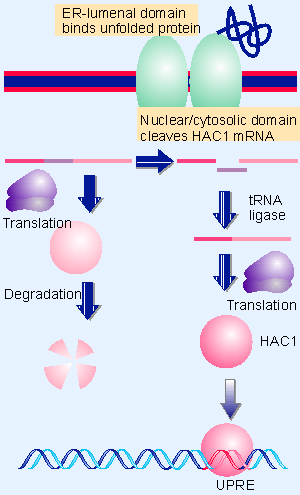 |
Figure 22.27 The unfolded protein response occurs by activating special splicing of HAC1 mRNA to produce a transcription factor that recognizes the UPR. |
The operation of the pathway is summarized in Figure 22.27. Under normal conditions, when the pathway is not activated, Hac1 mRNA is translated into a protein that is rapidly degraded. The activation of Ire1p results in the splicing of the Hac1 mRNA to change the sequence of the protein to a more stable form. This form provides the functional transcription factor that activates genes with the UPRE.
Unusual splicing components are involved in this reaction. Ire1P has an endonuclease activity that acts directly on Hac1 mRNA to cleave the two splicing junctions. The two junctions are ligated by the tRNA ligase that acts in the tRNA splicing pathway (Sidrauski et al., 1996; Sidrauski and Walter, 1997).
Where does the modification of Hac1 mRNA occur? Ire1p is probably located in the inner nuclear membrane, with the N-terminal sensor domain in the ER lumen, and the C-terminal kinase/nuclease domain in the nucleus. This would it enable it to act directly on Hac1 RNA before it is exported to the cytoplasm. It also would allow easy access by the tRNA ligase. There is no apparent relationship between the Ire1p nuclease activity and the tRNA splicing endonuclease, so it is not obvious how this specialized system would have evolved.
| Research | |
| Baldi, I. M. et al. (1992). Participation of the intron in the reaction catalyzed by the Xenopus tRNA splicing endonuclease. Science 255, 1404-1408. | |
| Mattoccia, E. et al. (1988). Site selection by the tRNA splicing endonuclease of X. laevis. Cell 55, 731-738. | |
| Reyes, V. M. and Abelson, J. (1988). Substrate recognition and splice site determination in yeast tRNA splicing. Cell 55, 719-730. | |
| Sidrauski, C. and Walter, P. (1997). The transmembrane kinase Ire1p is a site-specific endonuclease that initiates mRNA splicing in the unfolded protein response. Cell 90, 1031-1039. | |
| Sidrauski, C., Cox, J. S., and Walter, P. (1996). tRNA ligase is required for regulated mRNA splicing in the unfolded protein response. Cell 87, 405-413. | |